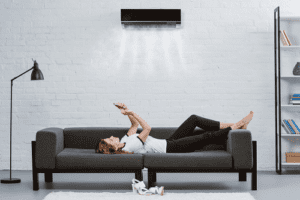When walking around a city or a particularly smoggy part of town, it’s easy to think about pollution and air quality. However, when we are in our homes, we don’t tend to have those same considerations. We’d all prefer to think of our homes as the safest and most secure places in our lives, and that feeling of security extends to air quality. Unfortunately, according to the Environmental Protection Agency (EPA), the air in our indoor environments is up to five times more contaminated than the air outdoors. This statistic sends many homeowners scrambling to purchase air purifiers to fix the problem. Before you invest in a new appliance, though, you might be wondering: “How do air purifiers work?” or “Do they even work at all?”
How Do Air Purifiers Work?
 One of the big challenges with indoor air quality problems is that they tend to worsen over time. Dirt, dust, pet dander, pollen, bacteria, mold spores, chemicals from cleaning products, and allergens build up in your home for a range of different reasons. When your HVAC system pulls in air to heat or cool the house, it is pulling in these contaminants as well. Many of them end up in your ducts and are circulated through your home again and again.
One of the big challenges with indoor air quality problems is that they tend to worsen over time. Dirt, dust, pet dander, pollen, bacteria, mold spores, chemicals from cleaning products, and allergens build up in your home for a range of different reasons. When your HVAC system pulls in air to heat or cool the house, it is pulling in these contaminants as well. Many of them end up in your ducts and are circulated through your home again and again.
The basic idea behind air purifiers is to remove those contaminants from the air so that they aren’t recirculated repeatedly. Like your HVAC system, a standard air purifier is designed to pull in the air from throughout your home, using a series of fans to do so. The air then passes through a filter (or several filters) which work to trap dust, dirt, bacteria, and other contaminants. The cleaned air is then released back out into your home. This process occurs repeatedly, gradually helping to purify the air throughout your house.
The above description applies to HEPA-filter air purifiers, which are the most common types of purifiers. Less common are ionic air purifiers, which use ionic generator technology to emit negatively charged ions throughout your home. The charge of these ions allows them to attract and attach to different particles in your air. This bonding process essentially weighs down the particles and drops them to the floor, where they can be vacuumed or mopped up and removed from the environment.
Are Air Purifiers Effective?
Statistically, air purifiers are believed to be effective at removing contaminants from the air. HEPA air filter purifiers can capture 99.97 percent of particles that measure 0.3 microns or more (which is to say, most contaminants). Statistics aren’t as readily available for air purifiers that use ionization technology—in part because they still require the extra step of vacuuming up the weighted-down particles. However, the general belief seems to be that air purifiers—at least high-quality units made by trusted brands—are effective for improving indoor air quality in a home.
There are a few caveats here, of course. First, most experts say that air purifiers need to run constantly to deliver real benefits. Air purifiers are small and there is a lot of air in your home. Over time, the cleaned air from the purifier will diffuse throughout the home, meaning there is always more “contaminated” air for the filter to draw in and clean. Only running the unit for part of a day or during the night, though, will mean it doesn’t have enough time to do its job effectively.
Secondly, as with any other system that uses filters, your air purifier will become less effective over time as its filter gets clogged up and dirty. Some air purifiers have filters that you can wash and re-use. Others will require you to replace the filter semi-regularly. In most cases, you will need to replace your air purifier filters every 3-6 months to get the best results. Some higher-tech units even have smart systems that notify you when a filter is dirty and needed to be washed or replaced.
Third, an air purifier is not a substitute for the other steps you can take to ensure superior indoor air quality at home. Instead, you should think of it as a way to supplement some of the other things you are already doing to create a healthier interior environment. Some of those other steps include vacuuming, dusting, and cleaning the house regularly; changing out your furnace filter every three months; and scheduling routine HVAC inspections and duct cleanings. These processes will all help to keep dust, mold, and other debris from building up in your home.
Every year, problems with indoor air quality lead to health issues, ranging from allergy flareups to respiratory disease and heart disease. Air purifiers may be a way to reduce those risks. Proper HVAC care and duct cleaning are certainly protective measures you can take. Contact your HVAC contractors today to ask about other methods for achieving superior air quality at home.

